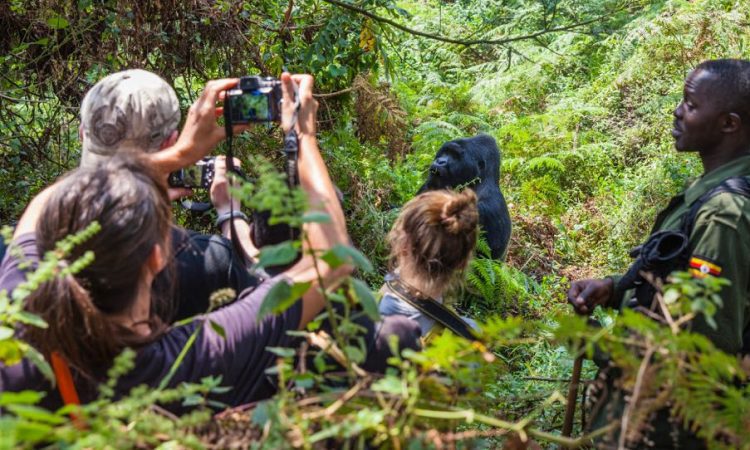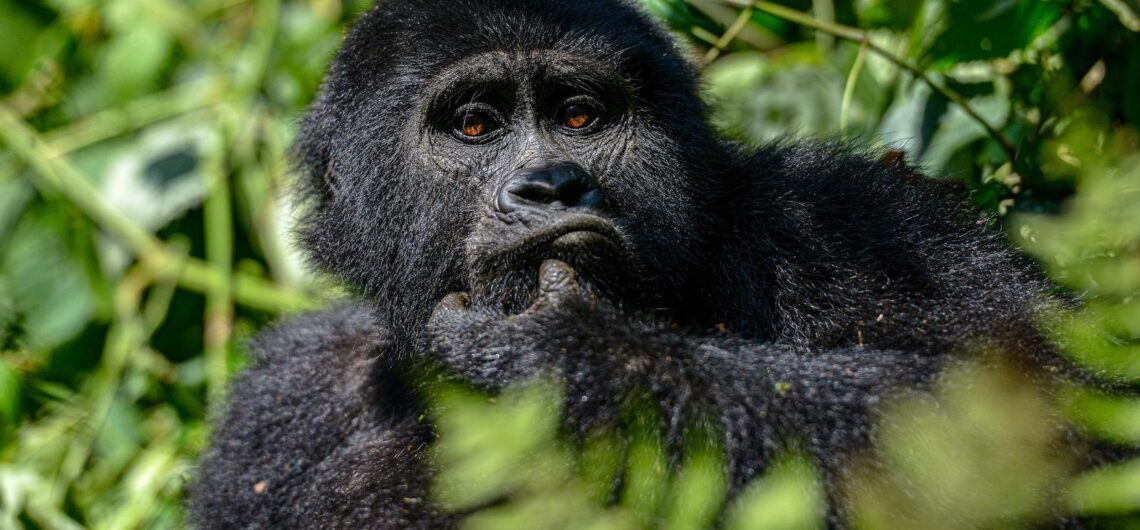Gorilla Photography: Because gorillas are one of our closest cousins, taking their pictures is a lot of fun. Everyone who like wildlife should try to observe them in the wild at least once in their lives. To find the primates, gorilla trackers must hike far into Africa’s jungles. The fact that a team of advance trackers was sent earlier to determine their precise location ensures that they will be found. The Guide and Rangers will be in continual contact with the advance trackers to determine the best path to take while the visitors are travelling. The Rangers will observe the gorillas’ mood after you locate them before allowing visitors to begin taking pictures and films.
When a tourist signs up for a gorilla tour, they all aspire to get good pictures of the primates. We are most closely related to gorillas. Only 1000 mountain gorillas remain in the Bwindi, Mgahinga, Virunga, and Volcanoes National Park forests. Hence, it’s crucial to snap top-notch pictures of the primates so that you may post them on your various social media pages and share them with your friends, family, and the rest of the world. If you work as a professional photographer or are a member of a film crew, you may wish to read both our articles on utilizing drones when gorilla trekking and filming gorillas.
Gorilla photography in Uganda and Rwanda
You must first find gorillas in order to take their pictures. We hope you chose a fascinating and appropriate gorilla group to track. In Uganda, 10 gorilla groups are habituated, 10 are in Rwanda, and 8 are in the Congo. Every gorilla group is unique and has a different mix of people. Certain gorilla populations have more individual animals, more silverbacks, more nursing mothers, and younger. In order for your tour operator to make arrangements for you to monitor a gorilla troop of your choice, you must inform them of your preferences in advance.
These days, it is more challenging to track a group of your choosing because gorilla groups are now assigned based on age and overall tracker fitness. However, influential tour companies can still ensure that you get a larger family or an easier trek.
Depending on where the group is located and the general landscape, photographing gorillas can be straightforward, challenging, or even aggravating. For unskilled photographers, the tropical rains, dense trees, and resulting low light conditions may also be a difficulty. It’s also vital to keep in mind that gorillas are often reserved primates, especially the adults. They don’t sustain direct eye contact for very long, so you’ll need to be creative and utilize a good camera if you want to capture a range of facial expressions. While the majority of people want to capture clear photographs that show the gorillas from every angle, it’s equally vital to take the time to observe and appreciate the amazing experience.
Note: As you will also learn from our articles on gorilla trekking regulations and gorilla charging, never use flash when taking pictures of gorillas. On general, gorillas dislike flush cameras and may become agitated or even charge if you’re unlucky.

Gorilla Photography Tips in Congo, Rwanda and Uganda
Here are some things to consider when planning a gorilla photography safari: –
Terrain and Vegetation: Gorillas inhabit deep forests and occasionally the slopes of mountains. There may be many obstacles in the way of your family portrait, such as leaves, vines, and tree brunches. Several mountain gorilla populations reside in high-altitude regions. This is especially true if you intend to go gorilla trekking in Uganda’s Mgahinga National Park and Rwanda’s Volcanoes National Park. In order to have less distractions, you must be well-positioned.
Gear and protective equipment: Going prepared is essential given the challenging terrain in the jungle. Rain falls in tropical jungles even when it’s dry out. As a result, you need make sure that your cameras and other relevant equipment are protected. A rain-proof bag will be useful in this regard and assist shield your cameras from harm. Additionally, don’t forget to pack adequate memory cards and camera batteries.
Telephoto Zoom Lens: The environment in which the primates will be found is unpredictable. When they forage, gorillas occasionally wander from one location to another. You can take pictures of gorillas even when they are far away with a telephoto lens on your camera. For close-up photography, lenses in the 200mm to 300mm range work well, but we advise using ones in the 400mm range to capture sharp pictures no matter how close you are to the monkeys. You might want to think about X-factor Lenses if you want to take images that are unusual or distinctive from the norm. Professional photographers who want to create spectacular photographs to sell or share online frequently use X-factor lenses.
Consider Shooting on burst mode: This is crucial if you wish to photograph adult gorillas’ facial expressions. A gorilla’s facial expression can change in just a few seconds. You must take multiple photos at once in order to acquire the greatest pictures. To capture the best possible images, the camera must be properly set up. It’s critical to keep in mind that mountain gorillas are large animals with black coats. If certain cameras are not properly positioned, the dark clothing and green surroundings can confuse the light emanating from them. In order to prevent overexposure, set your camera properly.
Go with a second camera: If for some reason the first one doesn’t work, this will be useful. Make sure the second camera is a different kind so that you may compare the results from two different lenses.
Camera Weight: Travel with a lightweight camera if at all possible. Depending on where the gorilla family you are tracking is located, gorilla tracking can take anywhere from 2 to 6 hours to complete. If you have very heavy cameras, don’t worry. For a nominal price of around $15, porters are available at every gorilla park to assist visitors with any heavy baggage and equipment.
Other things to consider when planning for a gorilla photography safari.
Always pay attention to park guides’ advice when capturing pictures of mountain gorillas. Keep in mind the gorilla trekking guidelines, which include maintaining a minimum distance of 7 meters, avoiding lengthy direct eye contact, and standing taller than the primates when they approach you.
Remember that if you choose the normal gorilla trekking, you will only get an hour to take pictures of the gorillas. Go for the more expensive gorilla habituation experience, which allows visitors to spend 4 hours with the primates, if you want to spend more time with them. Only in Uganda’s Bwindi Impenetrable National Park is it feasible to become accustomed to being around gorillas. There is a drawback to the Bwindi gorilla habituation experience. You would be following gorilla groups that are still getting used to you. It might be more difficult to get too close without waking the primates up.
Mountain gorillas are more docile and approachable than other large apes, making them ideal for photography. As they browse on the forest flows, they tend to remain in one spot for a while because they are not as mobile as chimpanzees. You can go closer to habituated mountain gorillas than you can to most other primates. In spite of this, you must keep your distance from the closest gorilla at least 7 meters. Once you’re in the gorillas’ presence, it can be very challenging to carry out this. It could be hard to stay away if they become close to you.
Don’t forget to bring a raincoat and reliable hiking boots to handle the challenging terrain. Keep in mind that the dense rain forest is where you will be looking for the primates. Go during the dry seasons if you can. Between December and March and June and August are the dry seasons. East and Central Africa’s busiest travel times are now. As this is when most visitors schedule their safaris in Africa, you should reserve your gorilla tour as soon as you can.


Comments